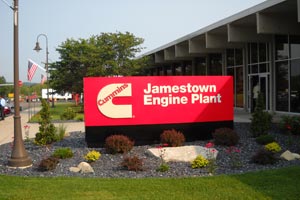Cummins Boosts Plant Spending in Bid to Make 500 Engines Daily

This story appears in the Aug. 18 print edition of Transport Topics.
LAKEWOOD, N.Y. — Independent engine maker Cummins Inc. is boosting its annual rate of investment in its 40-year-old Jamestown Engine Plant here by more than 50%, with a goal of building 500 engines a day, most of them ISX15s.
At a 40th anniversary celebration earlier this month for the plant, the company’s home for heavy-duty truck engines, executives said they will spend more than $30 million a year through 2016, up from $19.3 million in 2013.
“We’ve been investing here heavily,” said Dave Crompton, president of Cummins’ engine business since July. “We’ve been investing on capacity for the last 18 to 24 months, and we feel good about our footprint now.”
PHOTO GALLERY: Go inside Cummins' Jamestown plant.
The plant currently makes about 480 engines a day, with capacity growing by 22% from 2007 through last year.
Cummins held 39% of the market during the first half of this year, according to WardsAuto.com.
The Jamestown Engine Plant, once a metal-fabrication facility for the production of large filing cabinets, got under way in August 1974. At the time, Cummins still ran most of its production out of its headquarters city, Columbus, Indiana.
Five years later, in 1979, the company made its first engine here, a 10-liter model.
During 2002 and 2003 the company consolidated its heavy-duty production at the Jamestown plant, a 1 million-square-foot facility with about 1,500 nonunion workers
Even with truck makers’ in-house engines gaining market share, the Jamestown plant makes more heavy-duty truck engines — 10 liters of displacement or larger — than any other factory in North America, having cranked out a cumulative total of about 1.6 million since 1979.
Engine blocks come to the plant from foundries in China, Mexico and South Africa and get turned into 12- and 15-liter truck engines, in addition to some power plants for off-road applications.
The ISX15 is the company’s best seller for diesel truck engines, with most of them going to Kenworth Trucks, Navistar International and Peterbilt Motors. While the ISX12 using diesel has lost ground to the truck makers’ in-house models, the Jamestown plant is also home to the Cummins Westport ISX12 G, a natural gas power plant.
Plant manager Mike Abbate said finished engines get shipped to customers via truckload carriers, with each trailer usually holding 12 engines. On Aug. 8, when Cummins conducted plant tours, trucks from U.S. Xpress Enterprises, Werner Enterprises, the Gordon Trucking division of Heartland Express, UPS Freight and Schneider National were either picking up engines or delivering components.
Abbate said he schedules production based on filling up a trailer to go to a specific plant, such as Kenworth in Chillicothe, Ohio; Navistar in Springfield, Ohio, or Escobedo, Mexico; or Peterbilt in Denton, Texas. Trailers are filled with engines by truck maker specification so that the last unit loaded will be the first one out.
From Lakewood departure to truck installation is often less than one week, said Abbate.
“We’re part of a very tight supply chain. This is definitely just-in-time,” he said.
Cummins also showed off one of its two new Mobile Performance Labs — trailers that get pulled to the terminals of fleet customers to tweak the engines’ software.
Jim Kelly was plant manager in 1989-92 before serving as president of the engine business in 2005-10. Emerging from his retirement for the 40th anniversary, he said business was slow during his tenure.
“When I was here we made just 65 engines a day, four days a week. Back then many people didn’t think we’d be around to hit 40 years, but now this is one of the most profitable locations for Cummins,” Kelly said.
Dana Vogt was manager during 2005 and 2006 and is now vice president of manufacturing for heavy, medium and light-duty diesel engines for vehicles and electric power generation stations.
Crompton said the Jamestown Engine Plant is significant enough that it has its own engineering staff Engines go through the assembly line with a polished metal finish. When completed, a robot takes the engine to a test cell for an 8-minute test run. If the engine passes the test, it meets with another team of robots to get painted the company’s signature fire-engine red.

